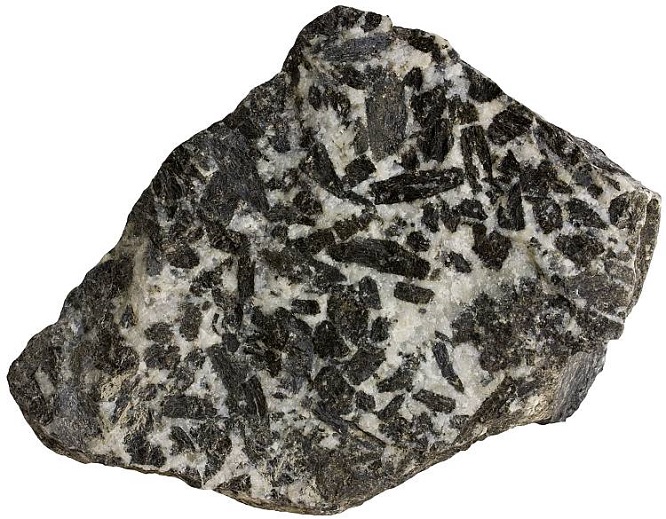Quartz gabbro
Gabbro: A coarse-grained plutonic rock composed essentially of calcic plagioclase, pyroxene and iron oxides.The term gabbro was used originally by Italian geologist Tozzetti in 1768 and brought into geological terminology by a German geologist Leopold von Buch. The name comes from the town Gabbro, a village in Rosignano Marittimo municipality of Tuscany (Italy). The pyroxene content is mostly clinopyroxene, generally augite, but small amounts of orthopyroxene may also be present. If the amount of orthopyroxene is more than 95% of the total pyroxene content then the rock is termed norite. Intermediate rocks are termed gabbronorite. The calcium rich plagioclase feldspar (labradorite-bytownite) and pyroxene content vary between 10% - 90% in gabbro, if more than 90% plagioclase is present, then the rock is an anorthosite, if on the other hand, the rock contains more than 90% pyroxenes (often both are present), it is termed pyroxenite. Gabbro may also contain small amounts of olivine (olivine gabbro) amphibole (hornblende gabbro) and biotite. The quartz content in gabbro is less than 5% of total volume, but quartz gabbros or monzogabbros are also known to occur, and are probably derived from magma that was oversaturated with silica. Gabbros may also contain moderate amounts of feldspathoid minerals (Foid -bearing gabbros) like nepheline, cancrinite, analcime and sodalite.
The main rocks type that are included under the term gabbro in the larger sense are:
• Gabbro (strict sense): augite, calcic plagioclase
• Olivine gabbro: augite, olivine, calcic plagioclase
• Troctolite: olivine, calcic plagioclase
• Norite: hyperstene, calcic plagioclase
• Anorthosite: calcic plagioclase
Gabbro can be formed as a massive, uniform intrusion via in-situ crystallization of pyroxene and plagioclase, or as part of a layered intrusion as a cumulate formed by settling of pyroxene and plagioclase. Cumulate gabbros are more properly termed pyroxene-plagioclase orthocumulate. Gabbro is an essential part of the oceanic crust, and can be found in many ophiolite. Long belts of gabbroic intrusions are typically formed at proto-rift zones and around ancient rift zone margins, intruding into the rift flanks.
.jpg)
Gabbro with large augite phenocrysts embedded in white plagioclase. These two are the principal minerals in this rock. Tangen, Norway. From Sand Atlas.

Gabbro with large augite phenocrysts embedded in white plagioclase. These two are the principal minerals in this rock. Tangen, Norway. From Sand Atlas.

Gabbro with labradorescent plagioclase (blue). From James St. John.
Bibliography
• Cox et al. (1979): The Interpretation of Igneous Rocks, George Allen and Unwin, London.
• Howie, R. A., Zussman, J., & Deer, W. (1992). An introduction to the rock-forming minerals (p. 696). Longman.
• Le Maitre, R. W., Streckeisen, A., Zanettin, B., Le Bas, M. J., Bonin, B., Bateman, P., & Lameyre, J. (2002). Igneous rocks. A classification and glossary of terms, 2. Cambridge University Press.
• Middlemost, E. A. (1986). Magmas and magmatic rocks: an introduction to igneous petrology.
• Shelley, D. (1993). Igneous and metamorphic rocks under the microscope: classification, textures, microstructures and mineral preferred-orientations.
• Vernon, R. H. & Clarke, G. L. (2008): Principles of Metamorphic Petrology. Cambridge University Press.


.jpg)
.jpg)
.jpg)
.jpg)
.jpg)
.jpg)
.jpg)
.jpg)
.jpg)